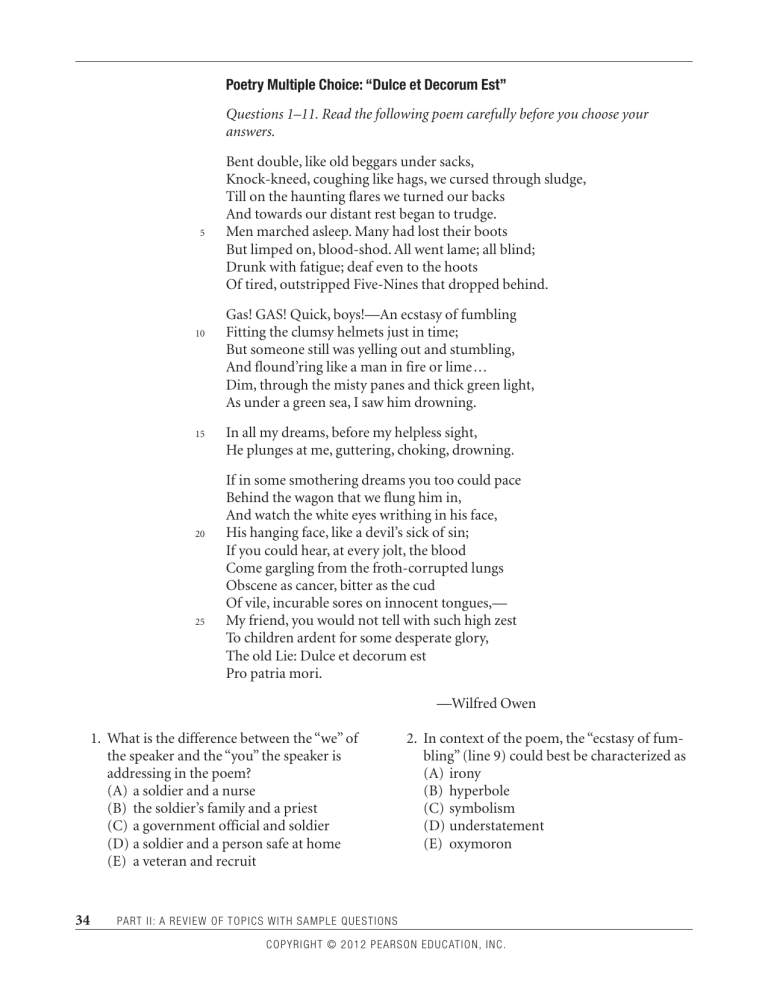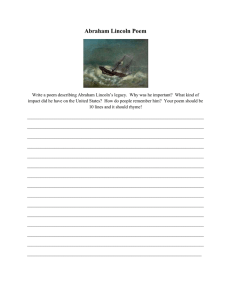
Poetry Multiple Choice: “Dulce et Decorum Est” Questions 1–11. Read the following poem carefully before you choose your answers. 5 10 15 20 25 Bent double, like old beggars under sacks, Knock-kneed, coughing like hags, we cursed through sludge, Till on the haunting flares we turned our backs And towards our distant rest began to trudge. Men marched asleep. Many had lost their boots But limped on, blood-shod. All went lame; all blind; Drunk with fatigue; deaf even to the hoots Of tired, outstripped Five-Nines that dropped behind. Gas! GAS! Quick, boys!—An ecstasy of fumbling Fitting the clumsy helmets just in time; But someone still was yelling out and stumbling, And flound’ring like a man in fire or lime ... Dim, through the misty panes and thick green light, As under a green sea, I saw him drowning. In all my dreams, before my helpless sight, He plunges at me, guttering, choking, drowning. If in some smothering dreams you too could pace Behind the wagon that we flung him in, And watch the white eyes writhing in his face, His hanging face, like a devil’s sick of sin; If you could hear, at every jolt, the blood Come gargling from the froth-corrupted lungs Obscene as cancer, bitter as the cud Of vile, incurable sores on innocent tongues,— My friend, you would not tell with such high zest To children ardent for some desperate glory, The old Lie: Dulce et decorum est Pro patria mori. —Wilfred Owen 1. What is the difference between the “we” of the speaker and the “you” the speaker is addressing in the poem? (A) a soldier and a nurse (B) the soldier’s family and a priest (C) a government official and soldier (D) a soldier and a person safe at home (E) a veteran and recruit 34 2. In context of the poem, the “ecstasy of fumbling” (line 9) could best be characterized as (A) irony (B) hyperbole (C) symbolism (D) understatement (E) oxymoron PA RT II: A REVIEW OF TOPICS WITH SAMPLE QUESTIONS COPYRIGHT © 2012 PEARSON EDUCATION, INC. 3. What is the clearest purpose of the poem? (A) to keep soldiers from enlisting in armies (B) to provide an non-romanticized depiction of war (C) to protest the use of toxic chemicals in warfare (D) to illustrate the importance of community on a battlefield (E) to chastise government officials 4. In lines 4 and 5, which sound technique dominates the flow? (A) onomatopoeia (B) cacophony (C) rhyme (D) assonance and consonance (E) alliteration 5. What is the effect of the repetition of the word “If ” in the last stanza? (A) add an air of plausibility to the situation (B) illustrate the dying soldier’s regret (C) force the older generation to see the effect of their words (D) create a sympathetic mood in the poem (E) none of the above 6. In the opening stanza, the chief purpose of the figurative language is to (A) portray cowardice (B) deglamorize war (C) humanize soldiers (D) rationalize war (E) celebrate bravery 8. What is a plausible reason for Owens’s choice of the Latin “Dulce et decorum est/ Pro patria mori” instead of the English,“It is sweet and fitting to die for one’s country”? (A) to instill the wisdom of the ancients (B) to use an antique saying to illustrate the consistency of the pattern (C) to maintain the meter (D) to add an aura of reverence to the deaths of the young men (E) none of the above 9. Which rhyme inherently conveys the conflict and message of the poem? (A) “sacks” (line 1) and “backs” (line 3) (B) “light” (line 13) and “sight” (line 15) (C) “blood” (line 21) and “cud” (line 23) (D) “glory” (line 26) and “mori” (line 28) (E) “sludge” (line 2) and “trudge” (line 4) 10. The final line of the poem—“Pro patria mori”—breaks the meter of the poem for what reason? (A) to illustrate the difference in meter between Latin and English (B) to reflect a truncated life of soldiers killed in action (C) to emphasize the poem’s rhyme (D) to pause for effect (E) to announce the theme of the poem 7. The use of the word “dreams” in the third and fourth stanzas could best be replaced with (A) hopes (B) illusions (C) goals (D) visions (E) nightmares PART II: A REVIEW OF TOPICS WITH SAMPLE QUESTIONS COPYRIGHT © 2012 PEARSON EDUCATION, INC. 35

